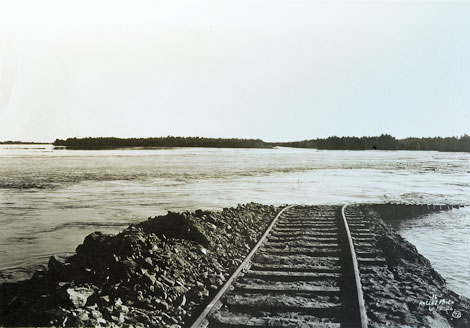

Financial problems continue to plague the Reclamation Service, resulting in the firing of its director, a name change, and a new "Commissioner." The newly-renamed Bureau of Reclamation must submit annual budgets to Congress to fund its projects like other Department of the Interior bureaus. New projects and a new focus make Reclamation a key player in supplying hydropower and municipal water to Western states. The Colorado River becomes the focus of debate and politics among seven Western states about who gets its water, leading to a new agreement among six of the seven Western states. Arizona dissents and battles California over water, a battle that, as it turns out, lasts decades.
Water Uses
Along with the challenge aridity presented in much of the West, the development of Western power generation was an equally formidable task. In the Salt River Valley, the inaccessibility of traditional power sources, such as timber and coal deposits, caused developers to ... more
 Flooding of the Imperial Valley in California during 1902-1905, when the Colorado River broke through its embankment, contributed to the decision to build a dam on the river. (Reclamation photograph)
Flooding of the Imperial Valley in California during 1902-1905, when the Colorado River broke through its embankment, contributed to the decision to build a dam on the river. (Reclamation photograph)Between 1905 and 1907, the Colorado River flooded several times. It broke through its banks, flowed into an "old channel" and inundated over 100,000 acres of fertile farm land in the Imperial Valley of Southern California. It devastated farmers and farm land alike, and left behind an inland lake known as the Salton Sea. At the end of World War I, the Imperial Irrigation District (in California) sought federal support for construction of a flood control and storage dam in the lower Colorado River Valley, most likely in the Boulder Canyon region. About the same time, the Reclamation Service also began looking at a dam on the lower Colorado River. In 1920, Congress authorized the Reclamation Service to develop preliminary plans for the All-American Canal in California and a storage dam on the Colorado River.
Reclamation Service director Arthur Powell Davis envisioned the new dam providing hydropower as well as irrigation water; the electricity generated by the dam would help pay for its construction. There was much politicking by private business interests that did not want to see the federal government encroach on private energy development. In the end, the Reclamation Service prevailed and began designing the new dam. By 1924, a dam site in Black Canyon, rather than the initial one in Boulder Canyon, was determined to be the preferred choice. The new location provided a larger reservoir pool and would be less costly to construct based on anticipated ... More
